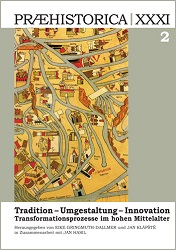Mittelalterliche Siedlungen in Sachsen, Sachsen-Anhalt, Ostfalen und Thüringen: Zur Fächer übergreifenden Erforschung des ländlichen Raumes vornehmlich aus archäologischer Sicht
Medieval Settlement in Saxony, Saxony-Anhalt, Eastphalia and Thuringia: On the Interdisciplinary Studies of the Rural Milieu mainly from an Archaeological Perspective
Author(s): Hans-Georg StephanSubject(s): Archaeology, Cultural history, Social history, Middle Ages, Social development, Rural and urban sociology
Published by: Univerzita Karlova v Praze, Nakladatelství Karolinum
Keywords: Middle Ages; settlements; cultural landscape; medieval archaeology; history; place-names; language; villages; deserted villages; Germany; central Germany; Saxony; Thuringia; Sachsen-Anhalt;
Summary/Abstract: Research about medieval settlements in Central Germany has a long tradition. In the 19th and up to the middle of the 20th century it was mostly a survey of written sources and analysis of historical maps whereas local people did most of all practical work in the field. A pioneer in archaeology then was Paul Grimm with his excavations and interdisciplinary work in the deserted village Hohenrode in the Southeast Harz region and in the nearby royal court at Tilleda. Because of the geographical situation not far to the eastern border of the Frankish and German Empire to the Slavonic areas there are not only very many early fortifications with an associated group of settlements but we can also identify most interesting acculturation processes. In spite of the fact that they have been known for a long time they still wait for analysis in modern multi disciplinary research. In the areas along the border zones also rural settlements were often protected by earthworks. Because of this and the establishment of “Grundherrschaft” in the zones dominated by the Saxon and Thuringian nobility the settlement structures seem to have been more stable than in the area of the Sorbic tribes. Still there is a great lack of research particularly in regard of the structure of the settlement landscape both in the traditional Germanic regions to the west of Saale and Elbe as well as in those areas which were in regard to their daily material culture we find during archaeological investigations much dominated by Slavonic traditions despite the political rule of Saxon and Frankish nobles, the king and ecclesiastical elites. The number of deserted medieval villages and the percentage of loss of fields seem to have been very different in special regions. Looking to this phenomenon it has not to be neglected that in areas which have largely stayed in the Slavonic style of life to the 11th/12th centuries the number of houses and inhabitants and the stability of the location has been much less than in the regions with predominating Germanic traditions. Modern interdisciplinary archaeological research regards to villages that have not been deserted in the middle ages are restricted to the areas with big scale coal-mining (“Braunkohlereviere”). From these small areas we recently have learnt a great deal about the development of single villages as well as about the settlement landscape. A more or less consequent care of governmental Heritage Management also for medieval settlements and other structures of the historical cultural landscape did mostly not develop before the 1990s and this caused quite a lot of small as well as some bigger new insights in the complex development both in time and space. The publications still rarely has been more than some precursory data and opinions. Longtime systematical research both in fieldwork and the analysis of data from excavations will be urgently needed for the future.
Journal: Praehistorica
- Issue Year: 31/2013
- Issue No: 2
- Page Range: 79-147
- Page Count: 69
- Language: German

